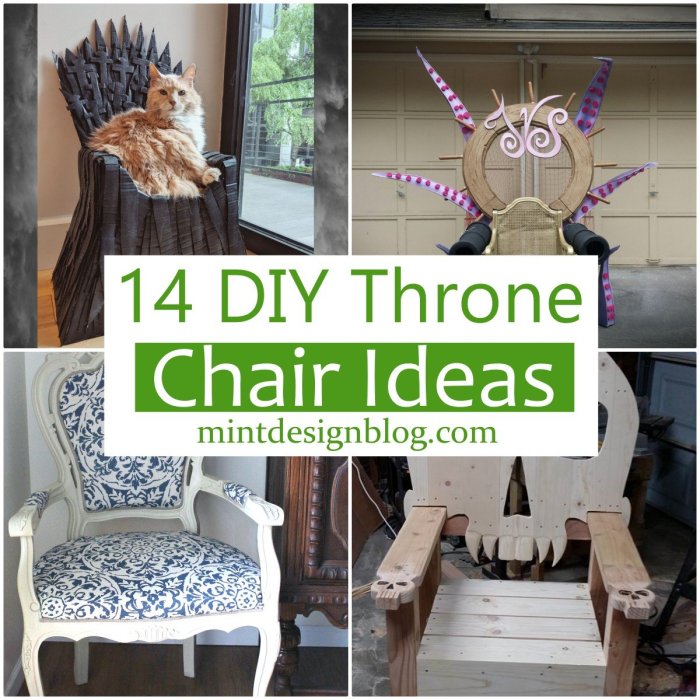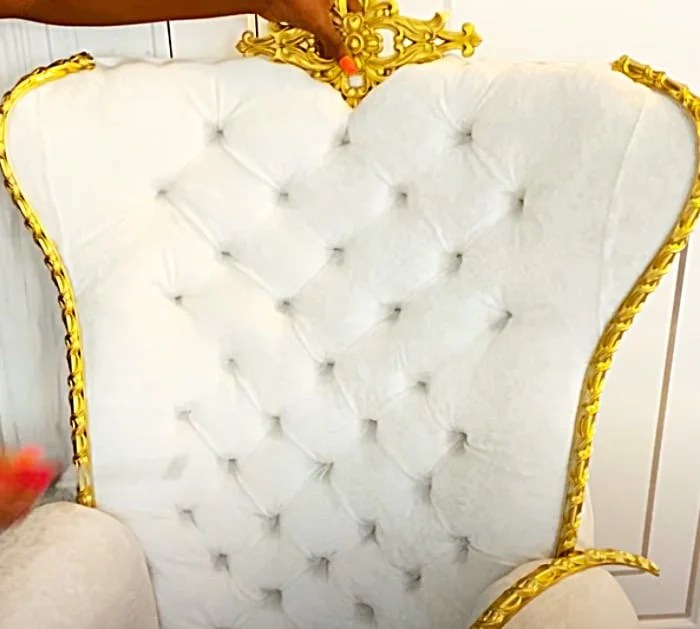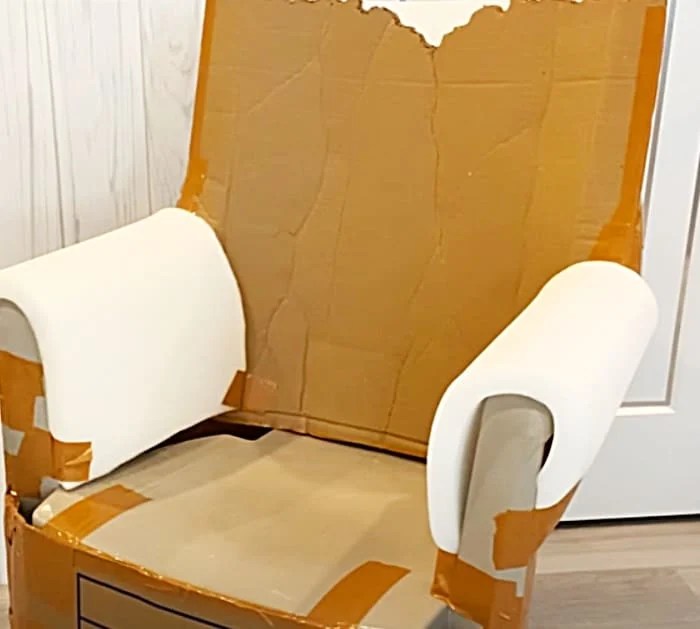DIY Throne Chair: Imagine a regal centerpiece in your home, a testament to your craftsmanship and creativity. Building your own throne chair is more than just a project; it’s a journey of personal expression, where every detail reflects your unique style and aspirations.
From the grandeur of a medieval castle to the elegance of a Victorian manor, a DIY throne chair allows you to create a statement piece that transcends time and adds a touch of enchantment to any space. Whether you envision a majestic throne for your reading nook or a playful seat for a child’s playroom, the possibilities are as limitless as your imagination.
The Allure of a DIY Throne Chair
There’s something undeniably captivating about the idea of crafting a throne chair with your own hands. It’s a project that blends practicality with a touch of whimsy, inviting you to step into the role of a skilled artisan while adding a unique piece of furniture to your space.
A Sense of Accomplishment and Personalization
Building a throne chair from scratch is a journey that fosters a deep sense of accomplishment. Every step, from selecting materials to assembling the final piece, is a testament to your creativity and handiwork. The process allows you to personalize your creation, making it truly your own. You can choose the style, materials, and embellishments that best reflect your tastes and personality.
Enhancing a Space and Reflecting Personal Style
A DIY throne chair can transform a room, adding a touch of regal grandeur or whimsical charm, depending on your design choices. Imagine a cozy reading nook with a plush, velvet-covered throne chair, complete with intricate carvings and a crown-shaped headrest. Or perhaps a modern living room featuring a sleek, minimalist throne chair crafted from reclaimed wood and accented with bold, geometric patterns. These are just a few examples of how a DIY throne chair can become a statement piece, showcasing your personal style and enhancing the ambiance of your space.
Design Considerations for a DIY Throne Chair

Crafting a throne chair that exudes grandeur and comfort requires careful consideration of various design elements. From the chair’s silhouette to the choice of materials, every detail contributes to its overall impact. Understanding the key design elements and exploring different styles will guide you in creating a throne chair that reflects your personal vision and provides a truly regal experience.
Key Design Elements
The design elements of a throne chair are crucial in achieving its majestic and comfortable qualities. These elements work in harmony to create a visually striking and functional piece.
- Height and Posture: A throne chair’s elevated height is a defining characteristic. The height should be such that the sitter feels empowered and commanding, but not so high as to be uncomfortable. The back support should be designed to promote good posture, preventing slouching and ensuring a dignified seating experience.
- Armrests and Backrest: Generous armrests provide a sense of security and comfort, allowing the sitter to relax and enjoy the grandeur. A high backrest, often with intricate carvings or upholstery, adds to the throne’s regal appearance and provides additional support.
- Materials and Finishes: The choice of materials plays a significant role in creating the desired aesthetic and durability. Traditional throne chairs often feature rich woods like oak or mahogany, while modern interpretations may incorporate metals, fabrics, and other materials. Polishes, paints, and finishes can add depth and richness to the throne’s appearance.
- Decorative Elements: Intricate carvings, embellishments, and upholstery can elevate a throne chair to a work of art. These details contribute to the throne’s grandeur and reflect the chosen style. Think about incorporating elements such as crown motifs, heraldic symbols, or ornate patterns to enhance the throne’s visual impact.
Throne Chair Styles
Throne chairs have evolved over centuries, reflecting different historical periods and cultural influences. Each style offers a unique aesthetic and design approach.
- Medieval Throne Chairs: These chairs often feature a sturdy, imposing design with a high backrest, armrests, and a footrest. Carvings depicting scenes from medieval life, religious motifs, or heraldic symbols are common. The materials used were typically oak or other hardwoods, often with dark finishes to enhance their grandeur.
- Victorian Throne Chairs: Victorian throne chairs are characterized by elaborate ornamentation and luxurious materials. They frequently incorporate intricate carvings, plush velvet upholstery, and gilded accents. The silhouette is often more graceful than medieval throne chairs, with a more curved backrest and armrests.
- Modern Throne Chairs: Modern interpretations of the throne chair often embrace minimalist design and innovative materials. They may feature sleek lines, geometric shapes, and the use of metals, glass, or leather. The focus is on functionality and a contemporary aesthetic, while still retaining the essence of a throne chair’s grandeur.
Designing a Comfortable and Aesthetic Throne Chair
Creating a throne chair that combines comfort and aesthetic appeal requires careful planning and attention to detail. Here are some design considerations to keep in mind:
- Seat Comfort: The seat should be generously padded and contoured for optimal comfort. Consider using high-quality foam or a combination of materials to ensure a supportive and comfortable seating experience.
- Back Support: The backrest should be tall enough to provide good lumbar support and prevent slouching. A slight curve in the backrest can enhance comfort and promote good posture.
- Armrest Placement: The armrests should be positioned at a comfortable height and angle, allowing the sitter to relax and rest their arms. Consider incorporating a slight curve or bevel to the armrests for added comfort.
- Aesthetic Harmony: The design elements should work together to create a cohesive and visually appealing throne chair. Consider the overall silhouette, the choice of materials, and the decorative details to ensure a harmonious design.
Construction Process: Step-by-Step Guide
The construction of a DIY throne chair can be a rewarding experience, allowing you to create a unique and personalized piece of furniture. This section provides a detailed guide to constructing your own throne chair, encompassing each stage from design to completion.
Materials and Tools, Diy throne chair
The first step in constructing your throne chair is gathering the necessary materials and tools. The materials will vary depending on the design you choose, but common materials include:
- Wood (e.g., hardwood, plywood, MDF)
- Foam padding
- Fabric (e.g., upholstery fabric, velvet, leather)
- Screws, nails, glue
- Hardware (e.g., hinges, casters, decorative accents)
The tools you will need include:
- Saw (e.g., circular saw, jigsaw, hand saw)
- Drill
- Screwdriver
- Measuring tape
- Level
- Staple gun
- Sandpaper
- Paint or stain (optional)
Cutting and Assembling the Frame
Once you have gathered your materials and tools, you can begin cutting and assembling the frame of your throne chair.
- Cut the wood pieces according to your design: This step involves using a saw to cut the wood pieces to the precise dimensions Artikeld in your design plan.
- Assemble the frame: This step involves joining the cut wood pieces together to form the frame of the chair. You can use screws, nails, or glue to secure the pieces.
- Reinforce the frame: It is important to reinforce the frame to ensure its stability and durability. This can be done by adding additional bracing or using thicker wood for key structural elements.
Adding Padding and Upholstery
After the frame is assembled, you can add padding and upholstery to create a comfortable and visually appealing throne chair.
- Cut and attach foam padding: Cut foam padding to fit the seat, back, and armrests of the chair. Secure the foam padding using staples or glue.
- Cut and attach fabric: Cut upholstery fabric to fit the seat, back, and armrests of the chair, leaving extra fabric for stapling. Attach the fabric using a staple gun, ensuring the fabric is taut and smooth.
Finishing Touches
The final stage of construction involves adding finishing touches to complete your DIY throne chair.
- Attach hardware: Attach any hardware such as hinges, casters, or decorative accents.
- Sand and finish the wood: Sand the wood frame to create a smooth finish. Apply paint or stain, if desired.
- Clean and inspect: Clean the throne chair to remove any sawdust or debris. Inspect the construction for any loose parts or defects.
Troubleshooting Tips
- Uneven frame: If the frame is uneven, you can use shims or adjust the screw lengths to level it.
- Loose joints: If you encounter loose joints, you can reinforce them with additional screws, nails, or glue.
- Uneven padding: If the padding is uneven, you can adjust the placement of the foam or add additional padding to create a more uniform surface.
Creative Variations and Personalization: Diy Throne Chair

The beauty of a DIY throne chair lies in its ability to reflect your unique style and preferences. You can go beyond the traditional design and explore a world of creative variations and personal touches that make your throne truly your own. This section delves into some exciting possibilities for adding your personal stamp to your throne chair.
Incorporating Different Materials and Styles
Beyond the classic wood construction, you can experiment with a range of materials to create a throne chair that aligns with your vision.
- Metal: For a modern and industrial aesthetic, consider incorporating metal elements like iron or steel. You can use metal tubing for the frame, metal sheets for the seat and backrest, or even decorative metal accents.
- Upholstery: Add comfort and elegance by upholstering your throne chair with fabrics like velvet, leather, or even faux fur. You can choose colors and patterns that match your existing decor or create a bold statement.
- Wicker or Rattan: For a rustic and natural feel, consider using wicker or rattan for the seat, backrest, or even the entire frame. These materials add a touch of warmth and texture to the throne.
- Recycled Materials: Embrace sustainability by incorporating recycled materials into your throne chair. Old pallets, reclaimed wood, or even discarded metal objects can be repurposed into unique and eco-friendly design elements.
Examples of Personalized Throne Chairs
Imagine a throne chair crafted from reclaimed wood, adorned with hand-painted murals depicting your favorite fantasy characters. Or a throne chair upholstered in vibrant red velvet, complete with intricate gold detailing and a custom-made crown cushion. These are just a few examples of how you can personalize your throne chair to reflect your individual interests and preferences.
Designing a Throne Chair with a Unique Feature or Theme
For a truly unique throne chair, consider incorporating a special feature or theme that aligns with your personality or passions.
- Bookworm’s Throne: A throne chair built around a bookshelf or a hidden compartment for storing your favorite books, complete with a comfortable reading nook.
- Gamer’s Throne: A throne chair with built-in gaming features like a cup holder, a headphone hook, and a comfortable backrest for extended gaming sessions.
- Music Lover’s Throne: A throne chair with integrated speakers, a built-in music player, or even a hidden compartment for storing musical instruments.
Tips for Successful DIY Throne Chair Creation

Crafting a DIY throne chair can be an exciting and rewarding project, but it also requires careful planning, attention to detail, and a touch of patience. By following these tips, you can maximize your chances of success and create a truly impressive piece of furniture.
Planning and Preparation
Before you begin, it’s crucial to have a clear vision of your throne chair. Consider the overall style, dimensions, materials, and any special features you want to incorporate.
- Create a Detailed Design: Sketch out your throne chair design, including measurements, materials, and any unique elements. This will serve as a roadmap for your project.
- Choose the Right Materials: Select high-quality materials that are durable, stable, and suitable for your design. Consider factors like wood type, upholstery fabric, and hardware.
- Gather Necessary Tools: Ensure you have all the essential tools for cutting, sanding, assembling, and finishing your throne chair. This includes saws, drills, sanders, clamps, and a variety of fasteners.
Construction Process
- Measure Twice, Cut Once: Accuracy is key when working with wood. Take precise measurements and double-check before making any cuts.
- Use Quality Fasteners: Invest in strong screws, bolts, and glue to ensure the stability and longevity of your throne chair.
- Sanding and Finishing: Smooth out any rough edges and imperfections with sandpaper. Apply a suitable finish, such as paint, stain, or varnish, to protect and enhance the wood.
Overcoming Challenges
- Seek Help When Needed: Don’t hesitate to ask for assistance from experienced woodworkers or DIY enthusiasts if you encounter difficulties.
- Embrace Adaptability: Be prepared to adjust your plans or techniques as needed. Flexibility is essential in DIY projects.
- Don’t Be Afraid to Experiment: Experiment with different techniques and materials to find what works best for your project.
With careful planning, a dash of creativity, and a touch of royal flair, you can transform your DIY throne chair from a mere project into a magnificent centerpiece. Embrace the challenge, enjoy the process, and revel in the satisfaction of creating a truly unique and personal masterpiece.
A DIY throne chair is a great way to add a touch of regal flair to your home. Whether you’re looking for a unique centerpiece for your living room or a fun project for a weekend afternoon, building your own throne chair can be a rewarding experience. If you’re looking for inspiration and ideas, check out the king of DIY website for a wealth of DIY projects and tutorials.
With a little creativity and effort, you can easily craft a throne chair that will make you feel like royalty.
